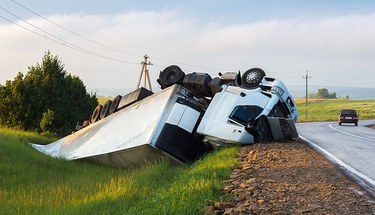Why 18-Wheelers Are So Dangerous When They’re Turning

If you have ever been on the road when an 18-wheeler is making a turn, you most likely are aware of the panicked feeling that you get when thinking that they may crash into your vehicle. This is something that many drivers feel when sharing the road with these large and intimidating trucks. While you may be under the impression that if you give the truck more than enough space that they will not hit you, the truth is that you can still end up being injured no matter how much room you give them.
According to Unitruck US, an 18-wheeler consists of two parts: the tractor (the actual “vehicle” part of the truck, with the engine and the cab) and the trailer. Together, these two parts form a semi-truck that weighs up to 80,000 pounds and stretches about 72 feet long and 13 feet tall. The size and weight of the semi-truck is what makes it dangerous when turning. These two factors not only make it difficult for truck drivers to control and maneuver their large vehicles, but they also cause them to need more time and space to make the turn or clear the intersection without striking another vehicle.
How do truck drivers cause accidents when turning?
Truck drivers are supposed to be educated and trained on how to make turns correctly and safely. In almost all circumstances they are required to have a commercial driver’s license (CDL) which allows them to drive this specific class of truck. But just because they’re supposed to be competent does not mean every trucker is safe behind the wheel – or that accidents don’t happen. Here are five common ways that truck drivers cause accidents when turning:
- Not using signals when turning: Truck drivers can cause accidents when turning by simply forgetting or choosing not to use their turn signals. This makes other drivers assume that they are going straight, which can cause a rear-end, underride, or pile-up accident.
- Not checking blind spots or surroundings: Just like passenger vehicle drivers, truck drivers are required to check their blind spots and surroundings before making a turn. However, semi-trucks have very large blind spots due to their size. This can make it extremely hard for truckers to see surrounding traffic or vehicles next to them while turning.
- Not ensuring that they can clear the turn: When a truck driver is at an intersection or any other busy road, they must make sure that they have enough time and space to clear the intersection and complete the turn before deciding to do so. If they do not do this, their large truck can block oncoming traffic, increasing the risk of underrides and multi-car wrecks.
- Going into other lanes when making wide turns: Truck drivers often find themselves approaching or crossing into other lanes when making wide turns. This is because the wheels of the trailer do not always follow the same path as the tractor during certain maneuvers. Encroaching into other lanes of traffic can cause obstructions to other travelers on the roadway.
- Not enough training or experience: Truck drivers who do not get the proper training or experience are more likely to cause accidents when making turns. Trucking companies that fail to train their drivers or to conduct proper background checks can be held liable for any accidents or collisions those drivers cause.
The types of turns that often result in dangerous truck accidents
Whether a truck driver is making a turn on a quiet local street or at a busy intersection, other drivers may be at risk. Therefore, the truck driver must take the necessary precautions to ensure that they can make their turn without putting anyone’s life in danger. The following are the types of turns that often result in dangerous truck accidents:
- Right turns: When a truck driver is making a right turn, they may need to swing their vehicle to the left to fully clear the turn. This may cause other drivers to think that the truck driver is turning left when they are actually turning right. As a result, the other drivers may try to pass the truck on the right, causing a sideswipe or T-bone collision.
- Left turns: Left turns usually take place at an intersection. Therefore, the trucker must remain directly in the center of the intersection before making the turn. If the truck driver tries to make the turn too soon or gets too close to the lanes of oncoming traffic, they can cause a serious accident.
- U-turns: U-turns are one of the most dangerous and difficult turns that a semi-truck can make. The reason for this is because truckers already have a hard time maneuvering and turning their vehicles. So, when they need to make a turn that forms the shape of the letter “U,” it often takes a lot of time and skill to successfully do this. In some circumstances and situations, relevant laws and regulations prohibit truckers from making U-turns because of the substantial risk associated with the movement.
However, even with skill and time, it can be almost impossible for the semi-truck to fully clear the turn without running into the curb. Therefore, they may need to put the vehicle in reverse a couple times, which can cause an automobile, motorcycle, bicyclist, or even a pedestrian to be hit or run over.
If you or someone you know has been hurt in a truck accident, please do not hesitate to get in touch with a dependable personal injury attorney as soon as possible. They will do everything they can to go above and beyond for you and your rights. This includes listening to your side of the story, reviewing the facts of your case, investigating what happened, determining liability, and finding out how much your case is worth.

